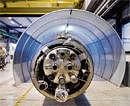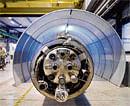

It was late on an August evening when the proton wranglers at the Large Hadron Collider finally got five trillion high-energy particles under control, squeezed and tweaked them into tight bunches and started banging them together. “Seven minutes too late,” grumbled Darin Acosta, a physicist from the University of Florida, whose shift had just ended.
On the walls around him, computer screens were blooming with multicoloured streaks and curling tracks depicting the primordial subatomic chaos of protons colliding 300 ft under his feet, in the bowels of the Compact Muon Solenoid, one of the four giant particle detectors buried around the collider ring.
A dozen or so physicists crowded around the screens, calling out the names of particles on the fly, trying to guess what others, as yet unknown to physics, were spraying from the mess in the middle, looking to see some sign from the universe. “This is way cool,” one of them said. “There’s a muon,” somebody else said as a spike darted out and into the void. “There’s a jet.” “This is good,” said Maria Spiropulu, a CERN and California Institute of Technology physicist. “This is very, very good.”
Mine of data
It has been seven months and some six trillion collisions since physicists at CERN – as the European Organisation for Nuclear Research is known – began running protons around their $10 billion, 18-mile electromagnetic racetrack underneath the Swiss-French border outside Geneva and smashing them together in search of new particles and forces of nature.
No new particles or forces have yet emerged, at least to the statistical satisfaction of the thousands of men and women now sifting through the debris from those collisions. Nor has the world disappeared into a black hole.
The machine will collide lead ions later in November and then shut down for the holidays. The collider will resume banging protons in February and run until the end of 2011. But CERN physicists say that data has already been accumulating faster than they can -analyse it, and that the collider has already begun to surpass its rival, Fermilab’s Tevatron.
In October, at a conference in Split, Croatia, Spiropulu showed fellow physicists a picture of a collision that could have produced one of the “dark matter” particles that astronomers say make up a quarter of the universe and are among the grand prizes of science these days.
Still under the cloud of Sep ‘08
It is one of handful of “interesting events” popping out of the collider that could change the world – if in fact they are real. But for all the euphoria in Geneva these days, the collider is still operating under the cloud of Sept. 19, 2008.
That is when the electrical connection between two of the collider’s powerful superconducting electromagnets exploded, turning one sector of the collider ring into a car wreck and shutting down the newly inaugurated machine for more than a year. As a result, the machine is operating at only half power, at 3.5 trillion electron volts per proton instead of the seven trillion electron volts for which it was designed, so as not to blow out the delicate splices.
At the end of 2011, all CERN accelerators will shut down for 15 months, so that the suspect splices – some 10,000 of them – can be strengthened and an unknown number of magnets that have lost the ability to handle the high currents and produce the high fields needed to run the collider at close to full strength can be “retrained.”
The collider will start up again in 2013 with proton energies of 6.5 trillion electron volts, but it is not likely to reach full power until 2014, if ever. In order to steer protons racing at more than 99 per cent the speed of light around the underground track, the collider’s electromagnets have to carry currents of some 12,000 amperes, which they can do only by being cooled by superfluid liquid helium to less than two degrees Celsius above absolute zero.
At that point, their niobium-titanium wires conduct electricity without resistance. The engineers had been able to cool each of the 10,000 or so superconducting magnets and test them before putting them in the collider, but they could not test the connections between them, Rossi said. Those connectors are sandwiches of superconducting wire and copper glued together with solder.
The copper is there to take over carrying the enormous current if the superconductor heats up in a so-called quench and loses its superconductivity – but only for the 100 seconds or so that it takes for the magnets to dump their enormous and dangerous energy.
Reviews that missed the point
Rossi said reviews had established that the collider’s design was very good, but it was not robust against faulty construction, like missing solder, which apparently is what caused the 2008 disaster. “Superconductivity calls for total quality; one mistake will undo the whole system,” Rossi said.
Undeterred by past disasters, CERN recently laid out plans for the next 20 years including an idea to swap out all its magnets in 2030 to increase the proton energies to as much as 33 trillion electron volts. The long hiatus has had a dramatic effect on the hunt for the collider’s main quarry, a particle known as the Higgs boson, which theory says is responsible for imbuing other elementary particles with mass.
The Higgs supposedly has a mass somewhere between 114 billion electron volts and 185 billion electron volts. By the time it shuts down in 2011, the CERN collider should have amassed about 20 times as much data as it now has, enough to make a dent in the Higgs hunt.
The lead in that quest currently belongs to the Tevatron, until last year the world’s largest accelerator, which has been colliding protons and antiprotons with energies of a trillion electron volts for the last two decades at the Fermi National Accelerator Laboratory in Batavia, Ill.
CERN and Fermilab deny they are in a race to find the Higgs or for predominance in physics.“Of course we feel a healthy competition with the Tevatron, let’s put it this way,” said Heuer.